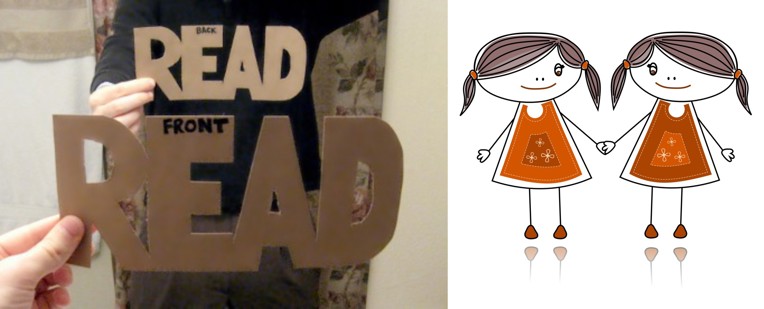
Why are only some identical twins considered mirror twins?
August 6, 2025

- Related Topics:
- Twins,
- Developmental biology,
- Appearance
A curious guest at The Tech Interactive asks:
"If all identical twins have the exact same DNA, why are only some considered mirror twins?"
If you went to high five yourself in the mirror using your right hand, what would you see? Your mirror image would also be holding up its right hand. Although it might seem like mirrors flip the image of ourselves left to right, they actually “flip” the image front to back. This makes the term “mirror twin” a misnomer!

Unlike your reflection in the mirror, identical mirror twins exhibit some traits, like a birthmark or dimple, on the opposite side of their bodies. For instance, if you were a mirror twin and you had a single dimple on your left cheek, your twin might have a single dimple on their right cheek. Interestingly enough, even orthodontic conditions, like the presence of extra teeth, can be mirrored!1
Identical twins are a rare occurrence: For every 1,000 births, only 3 or 4 will be identical twins. Mirror twins are even rarer, accounting for 25% of identical twins!1 But why aren’t all identical twins mirror twins?
How do twins form?
To answer this question, let’s start with how twins develop in general. Fraternal twins, who make up the majority of twins, form when two different eggs are fertilized by two different sperm in the same pregnancy. As with non-twin siblings, fraternal twins share about half of their DNA.

In contrast, identical twins form when a single fertilized egg, called a zygote, splits into two embryos at an early point of development. Each of these embryos develops into a fetus and, eventually, a baby. Identical twins have the exact same DNA and are always the same sex.
During pregnancy, each fraternal twin (typically) has their own placenta (organ which delivers oxygen and nutrients to the developing fetus) and amniotic sac (protective membrane). In contrast, each identical twin typically has their own amniotic sac but shares the placenta with their twin.
Why does this matter?
The timing of placenta formation can vary from one pregnancy to the next, and this variation can help explain the phenomenon of mirror twinning.
Let’s consider three possible timelines for identical twin formation1,2:
In the first timeline, the split happens within 4 days of fertilization of the egg by a sperm. In this case, the developing identical twins (like most developing fraternal twins) each have their own placenta and amniotic sac.

In the second timeline, the early stage embryo splits a little later, 4-7 days after fertilization. In this case, the developing identical twins share the same placenta but have their own amniotic sacs. This is the most common scenario for identical (non-mirror) twins.

Finally, in the third timeline, the embryo splits into two embryos even later, between 8 and 14 days after fertilization. In this case, the developing identical twins share the same placenta and amniotic sac. Researchers think that mirror twin development follows this third timeline, with the embryo splitting between 9 and 12 days after fertilization. This means that mirror image twins share a placenta and amniotic sac during the pregnancy. Sometimes, this poses a risk for the developing twins, if their umbilical cords become tangled in the shared amniotic sac. In rare cases, if the embryo splits past day 12, conjoined identical twins may develop.

Pick a side!
Some researchers think that “sidedness” (i.e., whether something is left-sided or right-sided) is determined very early in development. At the molecular level, scientists have discovered important signaling pathways that determine left/right asymmetry in our bodies.
The expression of a signaling molecule, called Nodal, for example, determines the position of our internal organs early in embryonic development. Scientists have studied this pathway in chicks: Disrupting proper Nodal signaling led to the random positioning of internal organs in the chick!3
Although the mechanisms of mirror twinning are not completely known, the delayed splitting of the embryo in Timeline 3 could mean that at the time of the split, the embryo already has a left and a right side. Thus, when it splits, the resulting two embryos have opposite sidedness.

Author: Deniz Bingul
When this answer was published in 2025, Deniz was a Neurosciences PhD candidate, studying cognitive function in a mouse model of Parkinson’s disease. Deniz wrote this answer while participating in the Stanford at The Tech program.
 Skip Navigation
Skip Navigation
